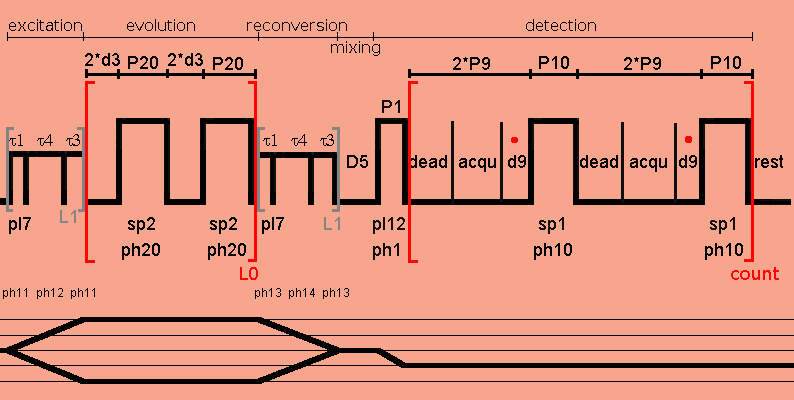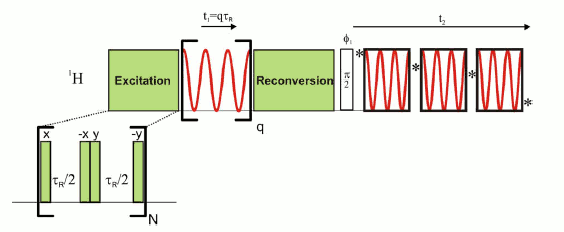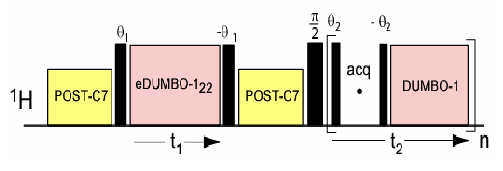
DUMBOdqPC7sqbsw1d: 1D big F1 spectral width 2Q - 1Q PC7 correlation with DUMBO decoupling pulse program (TopSpin2.1)

DUMBOdqPC7sqbsw1d: 1D big F1 spectral width 2Q - 1Q PC7 correlation with DUMBO decoupling pulse program (TopSpin2.1)

Since non-phase cycling is applied to the PC7 excitation pulse, four-phase cycling is applied to the detection pulse P1 for selecting the 0Q -> -1Q coherence order jump, and four-phase cycling is applied to the PC7 reconversion pulse for filtering DQ coherences.
;DUMBOdqPC7sqbsw1d ;1D DQ-SQ proton-proton shift correlation with POST C7 DQ excitation/reconversion ;with homonuclear DUMBO decoupling DQ evolution without prepulses during t1 ;and windowed DUMBO acquisition ;S. P. Brown, A. Lesage, B. Elena and L. Emsley, J. Am. Chem. Soc. 126, 13230-13231 (2004). ;modified after Leskes, Madhu and Vega, Chem. Phys. Lett. to remove center artefact ;using STATES-TPPI ;This pulse program was written according to the corresponding DUMBO-sequence from ;the ENS-Lyon Pulse Program Library ;p9 2.4-4.5 usec, depending on probe deadtime, usually: ;for 200 and 300 MHz, CRAMPS probe required or use 4.5 usec, ;acqu or p9 must be as short as possible, avoiding dipolar coupling effects between DUMBO sequences, ;l11 or d9 must be as large as possible to improve S/N ratio, but keeping acqu positive and small, ;p1 : 90 degree 1H detection pulse ;p2 : presaturation 90 degree pulse ;p9 : acquisition window, 1.7-4.5 usec, depending on probe deadtime ;p10: dumbo-1 pulse for t2 ;p20: dumber-22 pulse for t1 ;d0 : t1 value ;d1 : recycle delay ;d5 : z filter delay, 0.1 μs or multiple of 1/cnst31, otherwise no signal ;d20: delay between saturation pulses ;l0 : 0 as initial t1 ;l1 : number post-c7 basic cycle elements, for protons 2-4 in real solids ;l11: number of oversampled data points to be averaged into one dwell point ;l20: # of pulses in saturation pulse train, 0 if undesired ;pl1 : 1H presaturation power ;pl7 : 1H power for POST C7, B1=7*cnst31 in Hz ;pl12: 1H power for pulses P1 ;pl13: dumbo power ;sp1 : 1H power for windowed dumbo-1 (t2) ;sp2 : 1H power for dumber-22 (t1) (usually somewhat less power than sp1 since ; there is no window), set to pl13 as in setup experiments ;cnst1 : phase for PC7 reconversion pulse due to t1 evolution period ;cnst31: spinning frequency (usually not more than 15 kHz possible) ;NS : = 16*n ;zgoptns :-Dpresat or blank ;$COMMENT=homonuclear decoupling with w-DUMBO ;$CLASS=Solids ;$DIM=1D ;$TYPE=homonuclear decoupling ;$SUBTYPE=explicit acquisition ;$OWNER=hf ;cnst11 : to adjust t=0 for acquisition, if digmod = baseopt "acqt0=1u*cnst11" dwellmode auto #include <Avancesolids.incl> #include <Delayssolids.incl> "d3=p9" ;p9 sets the window to make sure it is in microseconds "d9=0.1u*(l11)" ;set the sampling window, defined in Avancesolids.incl "blktr2 = 0.6u" ;this opens the transmitter gate 0.6 usec before the ;pulse, so the transmitter noise is not sampled "d0=(l0*(2*d3+p20))*2" ;t1 "sp1=pl13" "sp2=pl13" define delay dead "dead=1.2u" define delay acqu ;small window, defined by d3, 2.5-4.5 usec depending "acqu=2*p9-1.2u-d9-.1u" ;on probe deadtime ;acqu or p9 must be as short as possible, avoiding dipolar coupling effects ;l11 or d9 must be as large as possible but keeping acqu positive define delay cycle "cycle=4*p9+2*p10+.2u" define loopcounter count "count=aq/cycle" ;make sure td datapoints are sampled define delay rest ;make sure sampling proceeds throughout the sequence "rest=aq-(count*cycle)" define pulse tau1 "tau1=((0.25s/cnst31)/7)" ; 90° pulse define pulse tau4 "tau4=((1s/cnst31)/7)" ;360° pulse define pulse tau3 "tau3=((0.75s/cnst31)/7)" ;270° pulse "d31=1.0s/cnst31" "cnst1=180*cnst31*d0" ;phase correction for PC7 reconversion pulse, ;due to t1 DQ evolution period, ;defined by the phase-time relationships 1 ze ;acquire into a cleared memory 2 d31 #ifdef presat ;set with -Dpresat pres, d20 ;delay between saturation pulses (p2 pl1 ph4):f1 ;saturation loop if required lo to pres times l20 #endif /* presat */ d1 ;recycle delay 10u reset1:f1 ;synchronise pulse and detection RF 1m rpp10 ;reset phase list pointer 1m rpp20 ;reset phase list pointer 1m rpp11 1m rpp12 1m rpp13 1m rpp14 10u pl7:f1 ;PC7 excitation: 3 tau1:f1 ph11 ipp13 ipp14 ;increment reconversion phase ph13 and ph14 pointers tau4:f1 ph12 ipp12 ;increment phase ph12 pointer tau3:f1 ph11 ipp11 ;increment phase ph11 pointer lo to 3 times l1 5 d3 ;DQ evolution: d3 (p20:sp2 ph20^):f1 ;dumber22 d3 d3 (p20:sp2 ph20^):f1 ;dumber22 lo to 5 times l0 6 tau1:f1 ph13+cnst1 pl7:f1 ;PC7 reconversion: ;increase ph13 by cnst1 due to evolution period tau4:f1 ph14+cnst1 ipp14 ;iincrease ph14 by cnst1 due to evolution period ;increment phase ph14 pointer tau3:f1 ph13+cnst1 ipp13 ;increase ph13 by cnst1 due to evolution period ;increment phase ph13 pointer lo to 6 times l1 d5 pl12:f1 ;z filter delay STARTADC ;prepare adc for sampling, set reference frequency, ;defined in Avancesolids.incl RESETPHASE ;reset reference phase (p1 ph1):f1 ;90° detection pulse at pl12 .1u DWL_CLK_ON 7 dead acqu d9 RG_ON .1u RG_OFF ;take l11 complex data points (p10:sp1 ph10^):f1 ;w-dumbo, use 24 usec at 600 MHz or higher dead acqu d9 RG_ON .1u RG_OFF (p10:sp1 ph10^):f1 lo to 7 times count ;make sure td points are sampled rest 1u DWL_CLK_OFF 1m ;DQ filtering (four phase cycling): 1m ip13 ;increments all phases of ph13 by 90° 1m ip14 ;increments all phases of ph14 by 90° ;1m ip13*16384 ;increments all phases of ph13 by 90° ;1m ip14*16384 ;increments all phases of ph14 by 90° rcyc=2 ;next scan ;The rcyc statement is used for acquisition loops ;based on adc rather than go=label. Do not ;specify phase programs behind rcyc 100m wr #0 ;save data exit ;finished ph1= 1 1 1 1 2 2 2 2 3 3 3 3 0 0 0 0 ph10= 0 2 ;windowed dumbo phase during t2 ph11 = (float,45.0) 0.00 51.43 102.86 154.29 205.71 257.14 308.57 ph12 = (float,45.0) 180.00 231.43 282.86 334.29 385.71 437.14 488.57 ph13 = (float,90.0) 90.00 141.43 192.86 244.29 295.71 347.14 398.57 ph14 = (float,90.0) 270.00 321.43 372.86 424.29 475.71 527.14 578.57 ;an overall constant phase shift of π/2 is applied ;to the reconversion pulse phases ph13 and ph14 for time reversal ;ph11=(65536) 0 9362 18725 28087 37449 46811 56174 ;ph12=(65536) 32768 42130 51493 60855 4681 14043 23406 ;ph13=(65536) 16384 25746 35109 44471 53833 63195 7022 ;ph14=(65536) 49152 58514 2341 11703 21065 30427 39790 ph4= 0 ;for presaturation pulse ph20=0 2 ;dumber22 phase during t1 ph30=0 ;needed for acquisition, involved in RESETPHASE ph31=0 2 0 2 1 3 1 3 2 0 2 0 3 1 3 1 ;involved in STARTADC ;ph31 = ph1 + 2*ph13 + 1

RN-DQ/SQ-DUMBO excitation pulse sequence.

BABA-DQ/SQ-SAM excitation pulse sequence.

DQ-DUMBO excitation pulse sequence.